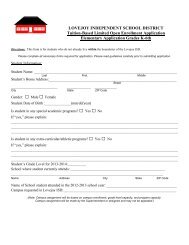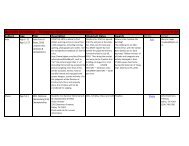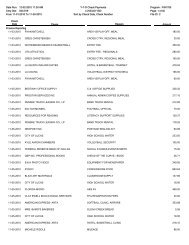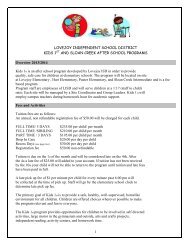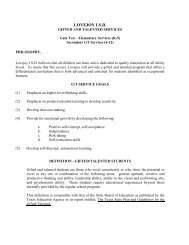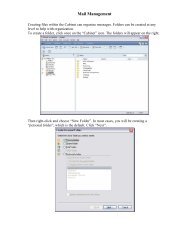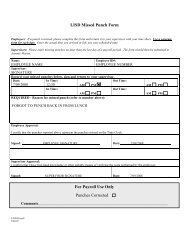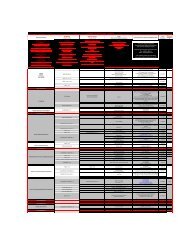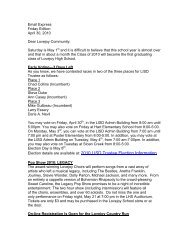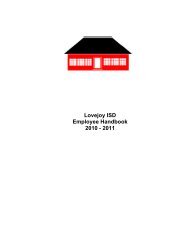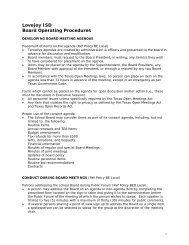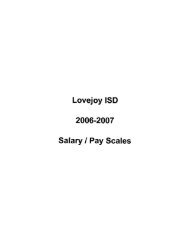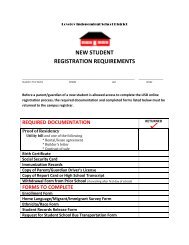g - Lovejoy ISD
g - Lovejoy ISD
g - Lovejoy ISD
You also want an ePaper? Increase the reach of your titles
YUMPU automatically turns print PDFs into web optimized ePapers that Google loves.
<strong>Lovejoy</strong> <strong>ISD</strong> Board Academy<br />
February 4, 2012
Welcome<br />
Ted Moore<br />
Superintendent
Agenda<br />
1. Welcome – Ted Moore<br />
2. Role of Board of Trustees – Ann Casey<br />
3. Candidate Process – Cindy Booker<br />
4. Academics – Dennis Muizers<br />
5. Special Education – Sancy Fuller<br />
6. Break<br />
7. Hiring Process – Tonya Vining<br />
8. Demographics – Dennis Womack<br />
9. Business Services – Shay Adams
Board Duties<br />
Ann Casey<br />
L<strong>ISD</strong> Board of Trustees, President
Mission Statement<br />
LOVEJOY <strong>ISD</strong>…..<br />
A school, in partnership with parents and<br />
community, committed to providing<br />
opportunities for students to reach their<br />
academic and personal potential in a<br />
changing world.
Board Duties<br />
Overview of School Board Responsibilities<br />
Structure of Governance in Texas:<br />
• Legislature<br />
• SBOE/Commissioner<br />
i<br />
• Local Board<br />
• Superintendent
Board Duties<br />
• By law, “An independent school district<br />
is governed by a board of trustees who, as<br />
a body corporate, shall oversee the<br />
management of the district.”<br />
• Because the board is a body corporate,<br />
members can perform no valid act except<br />
as a body at meetings properly convened<br />
and conducted. (Policy BBE Legal)
Legal Powers and Duties<br />
of the Board include:<br />
• Govern and oversee management<br />
• Adopt a policy to establish a planning<br />
process<br />
• Levy and collect taxes and issue bonds<br />
• Adopt and file a budget<br />
• Have fiscal accounts audited<br />
• Publish an annual performance report
Legal Powers and Duties<br />
of the Board include:<br />
• Receive bequests and donations for the<br />
district<br />
• Acquire and authorize sale of property<br />
• Exercise the right of eminent domain<br />
• Adopt a policy providing for employment<br />
and dd duties of personnel<br />
• Sue and be sued in the name of the<br />
district.
Defining Terms:<br />
Governance (the board’s authority)<br />
• Providing direction through the adoption<br />
of district goals and policies<br />
• Judging the accomplishment of district<br />
goals and the effectiveness of policies<br />
through the evaluation of the<br />
superintendent and the assessment of<br />
district results
Defining Terms:<br />
Management (The superintendent’s authority)<br />
• Putting plans, systems, procedures in place<br />
to accomplish desired outcomes and<br />
priorities<br />
• Monitoring plans, systems, and procedures<br />
for effectiveness in accomplishing desired<br />
results<br />
• Adjusting plans, systems, and procedures as<br />
deemed necessary
Defining Terms:<br />
Oversight of Management (The board’s<br />
authority)<br />
• Making sure goals are clearly defined<br />
• Making sure plans to achieve results exist<br />
• Making sure plans are monitored for<br />
effectiveness and changed if necessary
Defining Terms:<br />
Policy Development<br />
• Policy development is a cooperative effort<br />
involving the board, its local attorney, the<br />
staff, members of the community, and<br />
other information sources<br />
• Policy adoption is the function of the<br />
board
Defining Terms:<br />
Policy Development<br />
• Policy implementation is a function of the<br />
superintendent and staff<br />
• Policy review and evaluation is a function<br />
of the board based on information<br />
received from the staff, its local attorney,<br />
community, and other sources.
Defining Terms:<br />
Chain of Command<br />
• Concerns from citizens should be<br />
addressed to the authority closest to the<br />
problem, then the principal, other<br />
supervisor, and finally the<br />
superintendent before appealing to the<br />
board of trustees.
FAQ–Concerning Board Service<br />
How much time should I expect to spend on school<br />
board work each month?<br />
The board meets at 6 p.m. on the third Tuesday of each<br />
month. The end time varies, but 10 p.m. is typical. 72<br />
hours prior to the meeting trustees receive an electronic<br />
Board Book containing background information which<br />
must be read prior to the meeting. Allow one to two<br />
hours to read thoroughly.<br />
Occasionally, trustees will have other functions to attend<br />
such as an awards banquet, graduation, or a community<br />
information forum.
FAQ–Concerning Board Service<br />
What kind of training is required?<br />
New board members need about 18 hours of initial<br />
training i to understand d areas such as the open meetings<br />
law, school finance, board procedures, and policy<br />
development. After the first year, trustees complete<br />
about ten hours of continuing education each year.<br />
Training is offered by the Texas Association of School<br />
Boards twice in June. Trustees can attend the Summer<br />
Leadership Institute in San Antonio June 14-1616 or in<br />
Forth Worth June 28-30. TASB also offers training in<br />
many topics through online courses.
2011-2012 2012 Board Priority Goals<br />
1. <strong>Lovejoy</strong> <strong>ISD</strong> will leverage our technology<br />
resources to enhance teaching and learning to<br />
ensure that the standards-based approach is<br />
engaging, successful, efficient, and effective.<br />
2. <strong>Lovejoy</strong> <strong>ISD</strong> will continue to demonstrate growth<br />
in student academic achievement as evidenced by<br />
a broad range of measures including a TEA<br />
Rating of Exemplary as well as TEA Gold<br />
Performance Acknowledgements.
2011-2012 2012 Board Priority Goals<br />
3. <strong>Lovejoy</strong> <strong>ISD</strong> will develop math and science<br />
programs which: establish high standards of<br />
student learning, develop innovative approaches<br />
to teaching and learning, and serves as a<br />
lighthouse for math and science instruction in the<br />
K-12 arena.
2011-2012 2012 Focus Areas<br />
1. The <strong>Lovejoy</strong> Graduate Profile is integrated into<br />
the activities and curriculum at all grade levels<br />
and is extended into the community as<br />
appropriate.<br />
2. <strong>Lovejoy</strong> High School will provide an experience<br />
for its graduates that serves to transition them to a<br />
rich array of post high school options. The senior<br />
year serves as the culmination of a planned<br />
developmental approach K-12 designed to prepare<br />
all students for post high school opportunities.
Board Duties<br />
Ann Casey<br />
L<strong>ISD</strong> Board of Trustees, President
Candidate Process<br />
Cindy Booker<br />
Assistant to the Superintendent<br />
for Communication
Candidate Process<br />
• The <strong>Lovejoy</strong> <strong>ISD</strong> Board of Trustees consists of<br />
seven trustees serving terms of three years, with<br />
elections held annually. The terms of one-third<br />
of the Trustees, or as near to one-third as<br />
possible, expire each year. Education Code<br />
11.051(b), (),<br />
11.059<br />
• Election Day May 12, 2012
Candidate Process<br />
• Candidate packets are available at the<br />
Administration Building<br />
• Filing Deadline for a Place on Ballot –<br />
March 5, 2012 at 5:00 PM<br />
• More information is available on the<br />
District website select Board of Trustees<br />
and then Election Information
Candidate Process<br />
Cindy Booker<br />
Assistant to the Superintendent<br />
for Communication
<strong>Lovejoy</strong> <strong>ISD</strong> Academic Program<br />
Dennis Muizers<br />
Assistant Superintendent for Curriculum,<br />
Instruction and Assessment
<strong>Lovejoy</strong> <strong>ISD</strong> Academic Program<br />
• Three Objective Data Elements<br />
• The Texas Education Agency<br />
• The College Board<br />
• National Center for Educational Achievement<br />
(NCEA)<br />
• Measures include all levels of performance
TEA Data Elements<br />
• TEA<br />
• District ratings (focus on met standard of TAKS, % of<br />
students who meet ARD expectations, drop-out out rate)<br />
• Gold Performance Acknowledgements (focus on<br />
“advanced academics” with TAKS commended<br />
performance, advanced course enrollment, SAT/ACT<br />
averages, etc.)<br />
• Academic Excellence Indicator System (AEIS) annual<br />
report on data elements including staffing and general<br />
finance.
TEA Ratings for 2010-2011<br />
2011<br />
• Exemplary district<br />
•One of 61 in Texas<br />
• No TPM<br />
• Commended Performance of<br />
Econ. Dis.<br />
• All campuses Exemplary
Subject<br />
L<strong>ISD</strong> 2011 Met Standard<br />
d<br />
Percent<br />
Met<br />
Standard<br />
d<br />
Exemplary<br />
Performance<br />
Level<br />
Reading 99% √<br />
Math 97% √<br />
Writing 99% √<br />
Science 97% √<br />
Social Studies 99% √
L<strong>ISD</strong> 2011 Commended d Performance<br />
Subject<br />
Percent<br />
Commended<br />
Gold<br />
Performance<br />
Level<br />
Reading 63% √<br />
Math 60% √<br />
Writing 70% √<br />
Science 55% √<br />
Social Studies 73% √
Texas District TAKS 2010-1111 Ranking for<br />
Commended Performance Grades 3-11<br />
6<br />
1085<br />
L<strong>ISD</strong> is in the Top 1 %<br />
1144<br />
Writing 7<br />
2011<br />
18<br />
1171<br />
2010<br />
12<br />
1157<br />
2009<br />
2008<br />
7<br />
L<strong>ISD</strong> is in the Top 1 %<br />
1156<br />
1168<br />
Reading_ELA 9<br />
11<br />
1226<br />
4<br />
1225<br />
Math<br />
6<br />
6<br />
5<br />
6<br />
L<strong>ISD</strong> is in the Top 1 %<br />
1154<br />
1168<br />
1226<br />
1225<br />
Science<br />
13<br />
23<br />
26<br />
41<br />
L<strong>ISD</strong> is in the Top 1 %<br />
1131<br />
1147<br />
1213<br />
1210<br />
Social Studies<br />
15<br />
19<br />
11<br />
27<br />
L<strong>ISD</strong> is in the Top 1 %<br />
1070<br />
1098<br />
1156<br />
1157
District AEIS Summary<br />
• Exemplary Rating<br />
• Gold Performance Acknowledgments<br />
• Attendance Rate<br />
• AP Results<br />
• Commended<br />
• Reading/ELA<br />
• Math<br />
• Writing<br />
• Science<br />
• Social Studies
Gold Performance<br />
Ak Acknowledgments<br />
ld • Advanced Course/Dual Enrollment Course<br />
(30% or more) L<strong>ISD</strong> 51.4%<br />
• College Ready Graduates (40% or more)—<br />
L<strong>ISD</strong> 76%<br />
• Recommended HS or DAP (85% or more)<br />
L<strong>ISD</strong> 95.1%
SAT/ACT for 2010 and 2011<br />
Average SAT Score Mean Score # Test Takers<br />
2010 1086 137<br />
2011 1096 205<br />
Average ACT Score Composite<br />
Score # Test Takers<br />
2010 24 99<br />
2011 24 136
Impact of Income on SAT Mean<br />
• On every test section,<br />
moving up an income<br />
category was associated<br />
with an average score<br />
boost of over 12 points.<br />
• Moving from the<br />
second-highest income<br />
group and the highest<br />
income group seemed to<br />
show the biggest score<br />
boost.<br />
• However, keep in mind<br />
, p<br />
the top income category is<br />
uncapped, so it includes a<br />
much broader spectrum of<br />
families by wealth.
Advanced Placement Program<br />
• Students<br />
t<br />
• College-level level courses taught in a high school<br />
setting<br />
• International program with 34 courses and<br />
examinations offered in 19 subject areas<br />
• Most are junior and senior level courses<br />
• Educators<br />
• Workshops and institutes for teachers<br />
• Training for administrators
AP Exams<br />
• Approximately 3 hours in length<br />
• Two sections:<br />
• Multiple Choice (about 75 questions)<br />
• Free Response (essays and/or problems)<br />
• Scored on a scale of 1 to 5<br />
•Scores of 3, 4, and 5 usually considered to be<br />
equivalent to college scores of C, B, and A
L<strong>ISD</strong> 25 AP Courses<br />
AtHit Art History<br />
Macroeconomics<br />
Biology<br />
Music Theory<br />
Calculus (AB & BC)<br />
Physics B<br />
Chemistry<br />
Psychology<br />
Chinese Language<br />
Spanish Language<br />
Computer Science (A)<br />
Spanish Literature<br />
English Lang. & Comp.<br />
Statistics<br />
English Lit. & Comp.<br />
Studio Art (2-D, 3-D, and<br />
Environmental Science<br />
Drawing)<br />
European History<br />
US U.S. History<br />
French Language<br />
World History<br />
Government, U.S.
<strong>Lovejoy</strong> AP Philosophy<br />
While in the safer environment of home, all students<br />
who intend to be college bound should take at least<br />
one AP course before graduating.<br />
All students who enroll in an AP course are required<br />
to take the AP exam.<br />
Acting on this inclusive model creates a situation in<br />
which the percentage of students who score a 3 or<br />
higher as well as the test mean score could be<br />
lowered.
Benefits of AP as a Legitimate Choice<br />
• 2007 UT Austin Study<br />
• Students who have passed AP tests (scored 3 or<br />
better) do better than peers who have not taken<br />
AP courses or peers who have done dual<br />
enrollment while in high school.<br />
• Even students who score at 2 on an AP test<br />
perform better than peers who have not taken<br />
AP courses or peers who have done dual<br />
enrollment while in high school.
AP Enrollment in <strong>Lovejoy</strong><br />
• In 2010, LHS administered 587 AP tests in April.<br />
• In 2011 , 855 tests were given.<br />
• In 2012, 1350 tests projected this May.<br />
• In 2011, 75% (172 of 229)seniors took at least one AP<br />
course.<br />
• Of these 172 students, 61 (35%) took an AP course for the<br />
first time as a senior.
THE 2010 AP SCHOLARS<br />
AWARDS Compared to 2011<br />
‣AP SCHOLAR<br />
‣Scores of 3 or higher on 3 or more AP<br />
exams<br />
‣35 students in 2010, 42 in 2011<br />
‣AP SCHOLAR WITH HONORS<br />
‣Scores of 3 or higher h on 4 or more AP<br />
exams<br />
‣Average score of 3.25<br />
‣10 students in 2010, 21 in 2011
THE 2010 AP SCHOLARS<br />
AWARDS compared to 2011<br />
‣ AP SCHOLAR WITH DISTINCTION<br />
‣ Scores of 3 or higher on 5 or more AP exams<br />
‣ Average score of 3.5<br />
‣ 14 students in 2010, 21 in 2011<br />
‣ NATIONAL AP SCHOLAR<br />
‣ Scores of f4 or higher h on 8 or more AP exams<br />
‣ Average grade of 4 or higher<br />
‣ 2 students in 2010, 5 in 2011
AP Scholars<br />
• In 2010, <strong>Lovejoy</strong> <strong>ISD</strong> had 65 AP Scholars.<br />
• This represented 16% of the eligible<br />
students.<br />
• In 2011, <strong>Lovejoy</strong> <strong>ISD</strong> had 89 AP Scholars.<br />
• This represents nearly 20% of the eligible<br />
students.
AP Scholars and GPA<br />
• Of the 42 AP scholars, 24 were graduates in<br />
the Class of 2011.<br />
• Rank and GPA indicates:<br />
• 10 in top 25%<br />
• 9 in second quarter<br />
• 4 in third quarter<br />
• 1 in fourth quarter
NCEA (National Center for<br />
Eduational Achievement)<br />
• NCEA measures highest levels of state<br />
assessment performance (Commended<br />
Performance on TAKS)<br />
• NCEA recognizes schools based on student<br />
performance over time and demographics.<br />
• TBEC Honor Roll is based on NCEA data.<br />
Only top 4% of schools in Texas are<br />
honored.
District Practices<br />
• District Benchmarks<br />
• Collaborative Planning<br />
• Developing Mental Model of the appropriate<br />
depth and complexity of the TEKS<br />
• Interventions based on Data<br />
• Instructional ti lL Leadership<br />
• Professional Development
District Practices<br />
Our teachers have adopted the best practices of:<br />
• Teaching to the specifics in our state standards, the<br />
TEKS;<br />
• Planning collaboratively to share best ideas;<br />
• Benchmark testing about every 9 weeks to determine<br />
students’ mastery levels; and<br />
• Providing interventions for students to improve<br />
his/her performance.
<strong>Lovejoy</strong> <strong>ISD</strong> Academic Program<br />
Dennis Muizers<br />
Assistant Superintendent for Curriculum,<br />
Instruction and Assessment
Special Education<br />
Sancy Fuller<br />
Executive Director of Special<br />
Education & Academic Support
SPECIAL EDUCATION<br />
Supports for Students<br />
t<br />
PST 504<br />
Special<br />
Ed
PST: PROBLEM SOLVING TEAM<br />
• All campuses have a team in place<br />
• Group meets to determine if interventions<br />
and/monitoring is needed<br />
• Support provided in the area of academics<br />
and behavior
504<br />
• The purpose of the Section 504 of the<br />
Rehabilitation Act is to prohibit discrimination<br />
and to assure that students who are disabled, (a<br />
physical or mental impairment), have<br />
educational opportunities and benefits equal to<br />
those provided to non-disabled students.<br />
• Every campus has a Section 504 Coordinator<br />
• Accommodations
SPECIAL EDUCATION<br />
4000<br />
<strong>Lovejoy</strong> <strong>ISD</strong> SPED Student Ratio<br />
3500<br />
3000<br />
2500<br />
2000<br />
1500<br />
1000<br />
500<br />
0<br />
2007-2008 2008 2008-2009 2009 2009-2010 2010 2010-2011 2011 2011-2012<br />
2012<br />
Total # Enrolled 2501 2873 3229 3427 3550<br />
Total # SPED Students 152 177 213 246 254<br />
Total % of SPED Students Enrolled 6% 6% 7% 7% 7%<br />
* Data for 2011-2012 is as of 01/30/2012
SPECIAL EDUCATION cont.<br />
• Students<br />
• Parents<br />
• Post ARD Survey<br />
• Workshops<br />
• Build It And They Will Come<br />
• Staff
Special Education TAKS Participation Profile<br />
.<br />
Student Testing<br />
State Region 10 <strong>Lovejoy</strong><br />
Group<br />
TAKS or another 98.6% 98.7% 99.4%<br />
State Assessment<br />
One or more TAKS 91% 90.9% 95.6%<br />
tests<br />
Not tTested with<br />
76% 7.6% 77% 7.7% 38% 3.8%<br />
Regular TAKS test
Dyslexia<br />
• The program provides direct instruction for<br />
students in the areas of phonics & spelling.<br />
• All campuses have students that receive<br />
services from a dyslexia therapist.<br />
• TAKE FLIGHT-Multi-Sensory teaching<br />
approach (seeing,/hearing /touching)
COUNSELORS<br />
• Campus support for staff and students<br />
• Character lessons for students<br />
• Resource for parents & students<br />
• Cii Crisis Support
COMMUNITY<br />
Parent Support Groups<br />
• Provide almost monthly workshops on<br />
relevant topics (ADHD, Dyslexia, ARD<br />
Basics, Autism, Relaxation, etc.)
Special Education<br />
Sancy Fuller<br />
Executive Director of Special<br />
Education & Academic Support
Hiring Great Teachers<br />
Tonya Vining<br />
Executive Director of Human Resources
We believe that hiring the right people<br />
is one of our most important jobs;<br />
therefore, we place great emphasis<br />
on the hiring process.
Behavior Based Interviewing<br />
• Accuracy exceeds traditional interviewing<br />
accuracy by three to seven times<br />
• Improved accuracy makes Behavior Based<br />
interviewing extremely cost effective<br />
• Cream-of-the crop applicants prefer<br />
Behavior Based interviews & are more<br />
willing to accept jobs with organizations<br />
that use them
Behavior Based Interviewing<br />
• Based on the premise that past behavior is<br />
the best predictor of future performance.<br />
• Hiring decisions based on actual behavior<br />
are far more accurate than those based on<br />
gut feeling.<br />
• Must know what you are looking for to get<br />
what you want.
Behavior Based Interviewing<br />
• Decide what specific skills and experiences<br />
are necessary to ensure success of the new<br />
hire in your school setting<br />
• Design questions around those skills and<br />
experiences<br />
• Call upon the candidate to relate<br />
experiences in previous teaching, student<br />
teaching or field experience
Behavior Based Interviewing<br />
• Helps the interviewer sort the candidates<br />
• Have had the training<br />
• Know the pertinent skills<br />
• Able to start teaching on day one
The <strong>Lovejoy</strong> Way<br />
• Six hours per candidate<br />
• Three weeks<br />
• Team of administrators<br />
i
Important Attributes<br />
• Ability to build relationships with students<br />
and their parents<br />
• Undeniable mission<br />
• Highly coach-able<br />
able<br />
• Values working on a collaborative team<br />
• Effective teaching experience<br />
• Ability to demonstrate skills developed<br />
since becoming a teacher
Leave Nothing to Chance<br />
NOTES TO LOVEJOY <strong>ISD</strong> ELEMENTARY INTERVIEW TEAM:<br />
Prepare for Interview<br />
Gather Information<br />
Evaluate<br />
RATING DESCRIPTIONS:<br />
Outstanding Applicant = 5<br />
Above Average Applicant = 4<br />
Adequate Applicant = 3<br />
Below Average Applicant = 2<br />
Unacceptable Applicant = 1
Multi-Step Process<br />
• Paper Screen<br />
• Phone Screen<br />
• Round Robin Interview<br />
• Final Interview<br />
• Teach a Lesson
Written Exercise<br />
Please read article “Not Just a Necessary Evil” and respond to the questions below. You<br />
have 20 minutes to read and respond<br />
1. Although the article outlines the benefits of standards for large, urban districts, describe how<br />
standards can impact a district like <strong>Lovejoy</strong>.<br />
2. Describe your personal experience with one or more of the consistent benefits of standards<br />
found in the school districts that were studied for the 2004 Broad prize.<br />
3. What are your opinions of the pros and cons of standards (TEKS) and state assessment<br />
(TAKS) in Texas?
Round Robin Questions<br />
Station 2<br />
Scenario:<br />
You are a team leader and your team has been planning and working together since the<br />
beginning of school to try and align what you are presenting in class. You have given a<br />
critical nine week assessment. The results return and more than half of your team’s students<br />
have been unsuccessful on this critical assessment. Additionally, half of the students who<br />
failed missed more than half of the questions. Your students are frustrated and your team<br />
members are upset. You even hear some team members say, “It’s just that assessment.”
Interview Rating Form<br />
Very Strong<br />
Evidence Skill Is<br />
Present<br />
(5)<br />
Strong<br />
Evidence Skill Is<br />
Present<br />
(4)<br />
Some<br />
Evidence Skill Is<br />
Present<br />
(3)<br />
Strong<br />
Evidence Skill Is<br />
Not Present<br />
(2)<br />
Very Strong<br />
Evidence Skill Is<br />
Not Present<br />
(1)<br />
Teamwork /<br />
Leadership /<br />
Relationships<br />
Graduate<br />
Profile /<br />
Student<br />
Development<br />
Management of<br />
Tasks<br />
(C& I)<br />
Subtotal of each<br />
column<br />
Total of columns _________ Divided by 3 = ___________
Letter to Applicants<br />
Dear Applicant:<br />
Thank you so much for taking time to visit with us today. Over the next couple of weeks we will be<br />
completing our first round of interviews pulling from approximately 1,000 applicants who want to be a part<br />
of the <strong>Lovejoy</strong> family. We will contact those who we feel are qualified for the final round of interviews. We<br />
have less than five elementary school positions available between our three elementary campuses.<br />
If you are contacted to be involved in the next round of interviews, we will ask you to provide evidence of<br />
your success in the field. When requested please provide three of the following:<br />
1) A lesson plan<br />
2) Supportive student data<br />
3) An example of a major project description and rubric used<br />
4) Summary of Professional Development<br />
5) Example of effective use of technology in the classroom<br />
6) Video of your teaching/instructing<br />
We were honored to have met you and dthank you again for wanting to be a part of fthe <strong>Lovejoy</strong> family.<br />
Best Regards,
Final Call Back<br />
• Traditional final interview with the<br />
principal<br />
• Includes a central office team member<br />
• Asks follow-up questions based on round<br />
robin interview i and/or written exercise
Formal Induction Process<br />
• New hires invited to board meeting<br />
• Principals introduce each new hire to the<br />
board and the community<br />
• Receive a few tokens to facilitate their<br />
joining i<br />
of our team<br />
• PTA members are present to welcome them<br />
and give them a personalized note
Hiring Great Teachers<br />
Tonya Vining<br />
i<br />
Executive Director of Human Resources
Demographics<br />
Dennis Womack<br />
Assistant Superintendent for Operations
Puster ES<br />
Sloan Creek MS<br />
<strong>Lovejoy</strong> ES<br />
<strong>Lovejoy</strong> HS<br />
Elem #4<br />
Hart ES<br />
Willow Springs MS
Highest Ratios of Students per Home
Growing Developments
L<strong>ISD</strong> Growth Projections<br />
6000<br />
5500<br />
5000<br />
4500<br />
4000<br />
3500<br />
3000<br />
2011-12 2012-13 2013-14 2014-15 2015-16 2016-17 2017-18 2018-19 2019-20 2020-21
Elementary Seats -vs- Projected Enrollment<br />
2200<br />
2200<br />
2000<br />
2000<br />
1800<br />
1800<br />
1600<br />
1600<br />
1400<br />
1400<br />
1200<br />
1200<br />
1000<br />
1000<br />
800<br />
800<br />
600<br />
600<br />
400<br />
400<br />
200<br />
200<br />
0<br />
2011-12 2012-13 2013-14 2014-15 2015-16 2016-17 2017-18 2018-19 2019-20 2020-21<br />
0<br />
Elementary Seats<br />
Elementary Enrollment Projected
Middle School Seats -vs- Projected Enrollment<br />
1800<br />
1800<br />
1600<br />
1600<br />
1400<br />
1400<br />
1200<br />
1200<br />
1000<br />
1000<br />
800<br />
800<br />
600<br />
600<br />
400<br />
400<br />
200<br />
200<br />
0<br />
2011-12 2012-13 2013-14 2014-15 2015-16 2016-17 2017-18 2018-19 2019-20 2020-21<br />
0<br />
Middle School Seats Current<br />
Middle School Enrollment Projected
K-4 Elementary Seats -vs- Projected Enrollment<br />
2000<br />
2000<br />
1800<br />
1800<br />
1600<br />
1600<br />
1400<br />
1400<br />
1200<br />
1200<br />
1000<br />
1000<br />
800<br />
800<br />
600<br />
600<br />
400<br />
400<br />
200<br />
200<br />
0<br />
2011-12 2012-13 2013-14 2014-15 2015-16 2016-17 2017-18 2018-19 2019-20 2020-21<br />
0<br />
Elementary Seats<br />
Elementary Enrollment
Grades 5 & 6<br />
Seats -vs- Projected Enrollment<br />
1000<br />
1000<br />
900<br />
900<br />
800<br />
800<br />
700<br />
700<br />
600<br />
600<br />
500<br />
500<br />
400<br />
400<br />
300<br />
300<br />
200<br />
200<br />
100<br />
100<br />
0<br />
2011-12 2012-13 2013-14 2014-15 2015-16 2016-17 2017-18 2018-19 2019-20 2020-21<br />
0<br />
Intermediate School Seats<br />
Intermediate School Enrollment
1000<br />
Grades 7 & 8<br />
Seats -vs- Projected Enrollment<br />
1000<br />
900<br />
900<br />
800<br />
800<br />
700<br />
700<br />
600<br />
600<br />
500<br />
500<br />
400<br />
400<br />
300<br />
300<br />
200<br />
200<br />
100<br />
100<br />
0<br />
2011-12 2012-13 2013-14 2014-15 2015-16 2016-17 2017-18 2018-19 2019-20 2020-21<br />
0<br />
MiddleSchool Seats<br />
Middle School Enrollment
High School Seats -vs- Projected Enrollment<br />
1800<br />
1800<br />
1600<br />
1600<br />
1400<br />
1400<br />
1200<br />
1200<br />
1000<br />
1000<br />
800<br />
800<br />
600<br />
600<br />
400<br />
400<br />
200<br />
200<br />
0<br />
2011-12 12 2012-13 13 2013-14 14 2014-15 15 2015-16 16 2016-17 17 2017-18 18 2018-19 19 2019-20 2020-21<br />
21<br />
0<br />
High School Seats<br />
High School Enrollment Projected
Timeline for Facility Planning and Construction<br />
2011 2012 2013 2014 2015 2016 2017 2018<br />
J FMAMJ JASONDJ FMAMJ JASONDJ FMAMJ JASONDJ FMAMJ JASONDJ FMAMJ JASONDJ FMAMJ JASONDJ FMAMJ JASONDJ FMAMJ JASON<br />
WSMS<br />
LHS Phase IV<br />
Elem #4<br />
Planning<br />
Construction
Demographics<br />
Dennis Womack<br />
Assistant Superintendent for Operations
Business Services<br />
Shay Adams<br />
Chief Financial Officer
Overview<br />
• Budget Adoption Process / Calendar<br />
• Types of Funds / Tax Rates<br />
• Expenditures & Revenue<br />
• Internal Controls<br />
• Fund balance
Financial Opportunities<br />
• Provide excellent stewardship of taxpayer<br />
dollars<br />
• Maximize the return on investment of tax<br />
dollars<br />
• Keep our board, taxpayers and employees<br />
informed and educated on how school<br />
finance impacts <strong>Lovejoy</strong> <strong>ISD</strong>
Texas Education Agency<br />
Budget tD Deadlines<br />
Note: Two critical dates for budget<br />
preparation/adoption have been mandated by<br />
TEA<br />
(1) June 19th- the district budget must be prepared by this date<br />
(2) June 30th- the district budget must be adopted by the school<br />
board by this
School District Budget Process<br />
The budget process includes three basic steps:<br />
1. The establishment of an overall district revenue<br />
projection.<br />
2. The development of budgets or expenditure<br />
plans for each school and central office<br />
department.<br />
3. Review and approval of the district budget by<br />
the board of trustees.
Types of Funds<br />
General Fund – Operating fund aka Maintenance &<br />
Operation fund. The tax rate for this fund is currently<br />
$1.06 . With our taxable property value of<br />
$1,656,287,039 – we raise about $138,600 per penny<br />
of tax rate.<br />
Debt Service – aka Interest & Sinking fund used solely<br />
for the purpose of repaying debt incurred upon<br />
taxpayer approval. The tax rate for this fund is<br />
currently $.475.
Types of Funds<br />
Construction Fund – aka Bond funds. This funds serves as<br />
basically an escrow account that holds the proceeds of a bond<br />
issue (approved by the voters) until the projects are complete or<br />
partially complete and then builders, architects, vendors, etc. are<br />
paid from this account. There is no tax rate associated with this<br />
fund because the bonds are paid back through taxes collected in<br />
the Debt Service fund<br />
Child Nutrition Fund – This fund is supported by the sales of<br />
lunches and other food items in our cafeterias. The expenditures<br />
incurred df for the operations are offset by the revenue to make it a<br />
self-sufficient sufficient fund.
The Total Tax Rate<br />
Maintenance & Operations $1.06<br />
Debt Service $ .475<br />
Total Tax Rate $1.535
$29,385,927 Total Proposed Budget<br />
(2011-2012)<br />
2012)<br />
•Includes over $2 million in budget reductions<br />
•Includes $762K additions of:<br />
•Additional personnel / reassignment of personnel<br />
•One time payment per employee<br />
•Online Chinese Program<br />
•Fuel Cost Increase<br />
•School Bus Purchase<br />
•Apple Leases (year 1)<br />
•Includes both revenue & expenditure increases for Technology<br />
Allotment formerly recorded in another fund<br />
•Includes Set-aside for contingent personnel<br />
•Includes $500,000 Set-aside for designated fund balance
<strong>Lovejoy</strong> <strong>ISD</strong> Percentages by Object tCl Classification<br />
6100 – Personnel $22,646,526 77 %<br />
6200 – Contracted Services $ 2,800,753 10 %<br />
6300 – Supplies & Materials $ 2,071,289 7 %<br />
6400 – Travel & Other $ 1,229,629 4 %<br />
6600 – Capital Outlay/Fund Bal $ 637,730730 2%<br />
$29,385,927 100 %
Internal Controls<br />
• 77 % personnel costs are basically<br />
controlled by the board’s approval of new<br />
positions<br />
• 23% remaining budget is allocated to 18<br />
budget managers with local control codes<br />
that allow reporting and approval<br />
processing to be customized<br />
• ALL expenditures go through an intricate<br />
process for approval to expend
Internal Controls<br />
• Encumbrances<br />
• Purchase Requisitions<br />
• First layer is approved by one of the 18 budget<br />
managers<br />
• Second layer is reviewed for curriculum /<br />
program poga alignment twt with district<br />
dst • Third layer is reviewed for financial audit<br />
compliance<br />
• Fourth and final review is for purchase<br />
pricing/contract accuracy
Overall District Revenue Projection<br />
• Revenue is estimated/projected based on<br />
formulas provided and mandated by the<br />
state<br />
• Every publicly funded school district in the<br />
State of Texas uses the same template &<br />
components<br />
• Each district must a budget based on the<br />
projection…so it must be as precise as<br />
possible
Solving the Equation…<br />
• The components of the formulas include such numbers as:<br />
• Average Daily Attendance (ADA)<br />
• Determined by students & parents, as well as growth<br />
• State Assigned Taxable Value of properties within the district<br />
• Determined by the Comptrollers office vs Tax Appraiser based on<br />
economy & market<br />
• Tax collection rate<br />
• Determined by the taxpayers<br />
• Full Time Equivalents (FTE’s) of special populations served<br />
• Determined by individual student needs<br />
• Wealth Per Pupil<br />
• Determined by legislature l definition<br />
iti<br />
• Historical data referenced by legislation<br />
• Determined by legislative directive
Solving the Equation…<br />
• We must know the difference between what we<br />
CAN spend (cash flow) and what we SHOULD<br />
spend (funds earned)<br />
• TEA summary of finance is NOT a picture of<br />
what IS happening in our district this year, it is<br />
the most EDUCATED GUESS of what<br />
MIGHT happen in our district this year if none<br />
of the components change
Overall District Revenue Projection<br />
• Assumes an ADA of 3,372<br />
• Assumed a 6.7% reduction in<br />
funding for 2011-2012 2012 (until we<br />
had definite information from<br />
Legislature)
What does that mean?<br />
• Basically, the only way to increase revenue<br />
is to gain students<br />
• In order to fund increases in the budget,<br />
districts i must either operate in the deficit<br />
i<br />
(from fund balance) or cut costs in existing<br />
programs
Fund Balance History<br />
Fund Balance<br />
2005-2006 Fund Balance $ 7,933,935<br />
2006-2007 Fund Balance $ 8,152,344<br />
2007-20082008 Fund Balance (restated) $ 7,599,249<br />
2008-2009 Fund Balance $ 7,607,573<br />
2009-2010 2010 Fund Balance $8,334,014<br />
2010-2011 Fund Balance $9,096,757
Fund Balances<br />
Undesignated dF Fund Balance - Current tB Balance $8,152,052<br />
aka Savings Account. These funds are maintained by the district<br />
primarily to pay for operations and to utilize for cash flow prior<br />
to tax collections. They are also utilized to fund projects &<br />
improvements beyond the normal annual operations, (i.e. minor<br />
renovations of buildings, bus purchases, etc.)<br />
Designated Fund Balance – Current Balance $762,743<br />
With another $500,000 000 line item budgeted d in the 2011-2012<br />
2012<br />
Funds designated by action of the Board of Trustees for a<br />
specific intent (i.e. the transition into new building)
Function 35 – Student Nutrition<br />
Program<br />
$1,612,256<br />
Operation p of cafeteria<br />
Food, supplies & labor<br />
Operates to be self-sufficient program
Function 71 – Debt Service<br />
$6,900,876<br />
Repayment of debt approved by voters<br />
during bond election<br />
Separate ate portion o of tax rate (.475)<br />
Only use of these collections is for this<br />
purpose
Financial Transparency<br />
• Publication of accounts payable monthly check register for<br />
all district disbursements via link on <strong>Lovejoy</strong> <strong>ISD</strong> Website<br />
• FIRST report to continue and expand disclosures per<br />
House Bill<br />
• Superintendent’s current employment contract<br />
• Reimbursements to Superintendent and each school board member<br />
• Superintendent compensation from any outside source<br />
• Superintendent, executive level office and board member gifts<br />
received of $250 or more<br />
• Board member aggregate business transactions
Resources<br />
• Finance Reports<br />
• Monthly updates - Budget Status or Amendments<br />
• Quarterly updates - Investments & Estimates<br />
• Annual update – Independent Audit<br />
• L<strong>ISD</strong> Business Services Website<br />
• Check registers<br />
• Board Reports<br />
• Audits<br />
• Budgets<br />
• External Resources<br />
• Texas Education Agency – FIRST Rating<br />
• Texas State Comptroller – Gold Seal for Transparency<br />
• National Rating Agencies –S & P AA- & Moody’s Aa2
Business Services<br />
Shay Adams<br />
Chief Financial Officer



